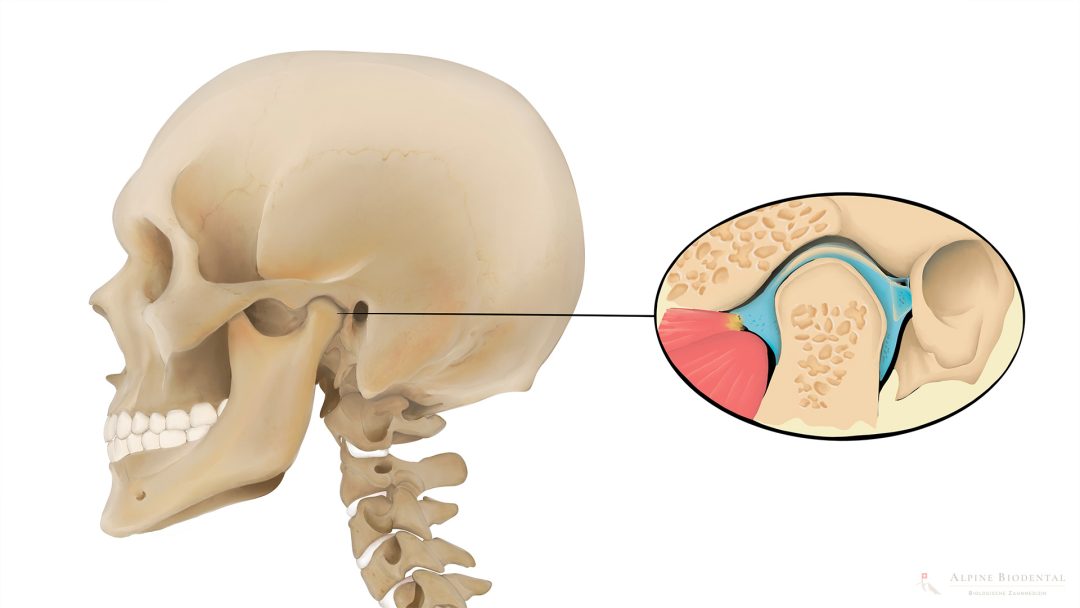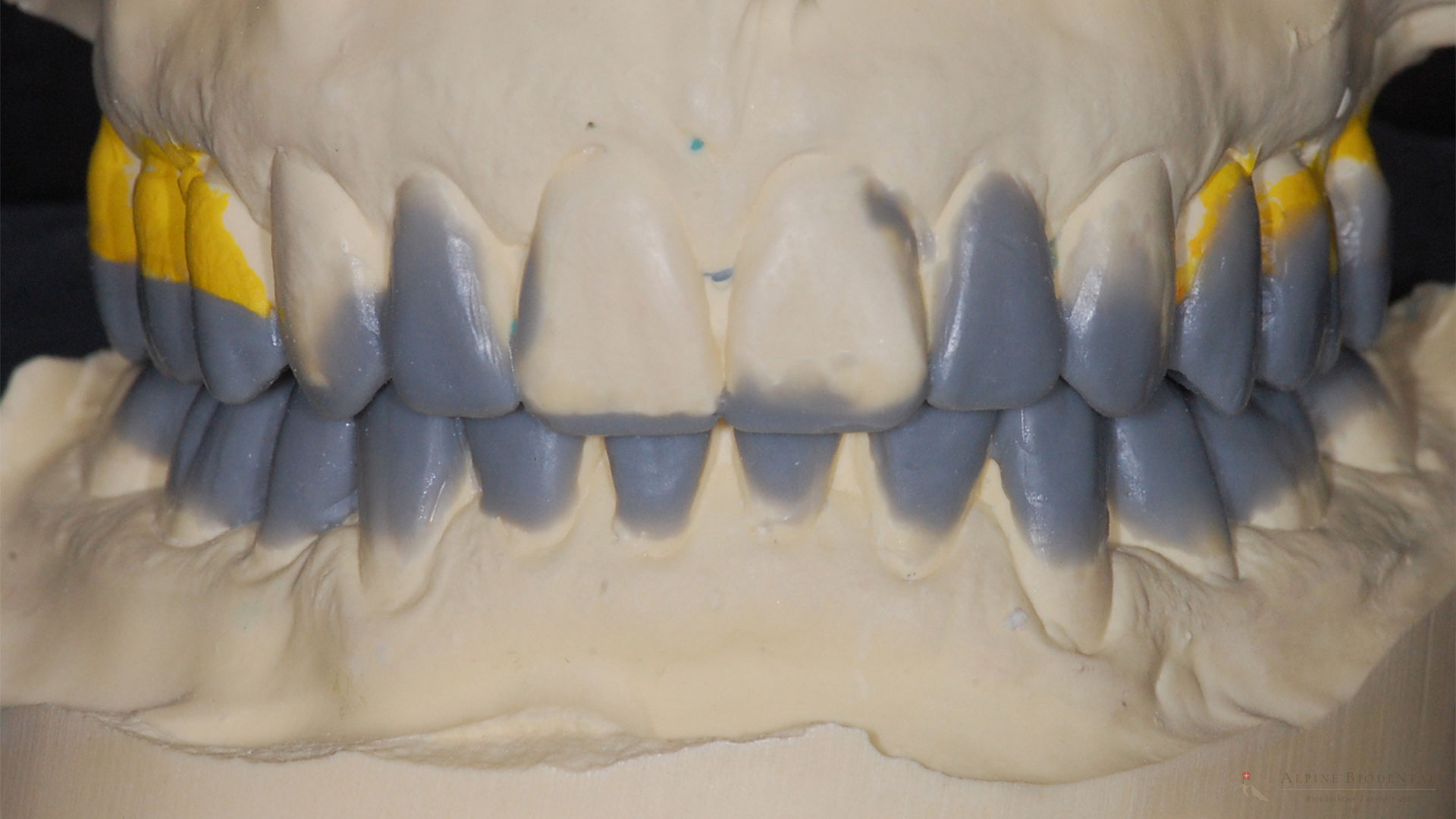TMJ, Temporomandibular Dysfunction of the Joint

The masticatory system of humans encompasses much more than just teeth or implants. It involves a complex interplay of teeth, periodontium, masticatory muscles, various ligaments, temporomandibular joints, ascending and descending nerve pathways, and delicate neurological control necessary for chewing our daily food. When the jaws are misaligned, pain in the chewing muscles, as well as headaches and other dysfunctions throughout the body, can occur. These physical problems are then referred to as TMJ.
What is TMJ?
The term TMJ stands for “Temporomandibular Dysfunction of the Joint,” meaning that the function of the lower jaw (Latin: Mandibula) to the skull (Latin: Cranium) is impaired. The correct term for dysfunction of the temporomandibular joint is “Temporomandibular Joint Dysfunction” or “Temporomandibular Joint Disorder” (often abbreviated as TMJ Dysfunction or TMD. Symptoms caused by TMJ can manifest locally in the masticatory muscles, as unattributed toothaches, facial, head, and neck pain, up to migraines, and can also affect the overall body’s statics. In many cases, the symptoms of TMJ may not immediately point to the teeth as the cause of the complaints.

TMJ Symptoms and Signs
The symptoms caused by TMJ can be diverse and not always immediately associated with teeth. Possible symptoms include:
- Teeth grinding and clenching (Bruxism)
- Increased wear of teeth
- Unclear toothaches
- Uncertain bite position, multiple possible bite positions
- Deep bite – teeth are too short, the lower face is proportionally too short compared to the entire face
- Jaw pain, often radiating to the temple
- Jaw feels tense
- Limited mouth opening
- Clicking and grinding of the temporomandibular joints
- Facial pain up to trigeminal neuralgia
- Various types of headaches
- Migraines
Due to the anatomical proximity of the inner ear to the temporomandibular joints, TMJ can cause:
- Tinnitus
- Dizziness
- Ear pain
- Hearing loss
Please note that these symptoms may also be associated with other causes that should be evaluated by an ear, nose, and throat (ENT) specialist.
The temporomandibular joints are considered the uppermost body joints and significantly influence body posture. Therefore, TMJ can trigger:
- Neck pain
- Shoulder pain
- Back pain
- Numbness in the arms and fingers
- Spinal deformities
TMJ Causes
The causes of temporomandibular dysfunction can be diverse, but there is always an imbalance between the position that the teeth take when fully biting and the healthy position of the temporomandibular joints as the central cause. In a functioning masticatory system, the upper and lower jaws, temporomandibular joints, masticatory muscles, and teeth work harmoniously together. If the teeth do not align in the correct position for the temporomandibular joints, the muscles cannot collaborate in their healthy movement patterns. In a disturbed masticatory system, the muscles must exert great effort to move the teeth together as dictated by the tooth position. This position harms the temporomandibular joints, causing them to shift to an unhealthy position.
The causes of this imbalance can be:
- Misalignment of teeth that develops during childhood
- Orthodontic treatments
- Accidents
- Non-optimally adapted dental prosthetics
- Teeth grinding and clenching (Bruxism), which exacerbates problems and leads to progressive wear of teeth, deterioration of bite position, temporomandibular joint damage, and increased muscle tension
- Stress: When stress is added to the listed causes, symptoms often become noticeable, leading to pain.
TMJ Diagnosis
Often, the beginnings of TMJ symptoms are accepted or attributed to other causes. Many patients who come to us have a long history of therapies that focused on symptoms but not on the causes of TMJ. Through an examination of the involved muscles, temporomandibular joints, the condition of the teeth, and bite position, a TMJ diagnosis can be clearly established.
As part of TMJ diagnostics, the TMJ specialist determines the correct position of the temporomandibular joints and works on it with the help of a special therapeutic TMJ splint (MAGO splint).
Please read more about TMJ diagnostics.
TMJ Treatment or TMJ Therapy
The treatment of diagnosed temporomandibular dysfunction occurs in three essential steps:
Splint therapy
The first step of TMJ treatment involves creating a special TMJ splint (MAGO splint). The MAGO splint, worn in the upper jaw, considers tooth sensory feedback and incorporates control elements to shift the masticatory muscles to a healthy movement pattern. At the beginning of therapy, the MAGO splint takes into account the position of the temporomandibular joints as best as possible. Due to existing muscle tension and disturbances in the temporomandibular joints, the exact healthy position of the temporomandibular joints is not precisely determinable in the first step. The MAGO splint allows the temporomandibular joints to undergo the initial regeneration. In regular sessions to adjust the MAGO splint, the regeneration of the temporomandibular joints is accompanied until they reach the fully healthy position. The embedded control elements help the masticatory muscles learn healthy movement patterns during this time.
Final diagnosis
When the temporomandibular joints are in their healthy position, the final diagnosis shows the exact, healthy alignment from the lower to the upper jaw. With this knowledge, the planning of the conclusive, causative therapy of TMJ can be reliably and with a high degree of certainty.

Wax-up before reshaping the bite Bite transformation
In the healthy position of the temporomandibular joints, the teeth must be adapted to each other to secure stable joint position and healthy bite height. The extent of the measures necessary for this varies widely and depends heavily on the initial situation. Biological dentistry offers various possibilities to adapt the teeth gently and metal-free to the healthy bite position. In some cases, a correctly planned orthodontic treatment needs to be included in the overall concept.
Interdisciplinary Therapy for TMJ
The cause of TMJ is always an incorrect bite position and height that does not match the healthy position of the temporomandibular joints. As a consequence of TMJ or independently of it, tensions and malpositions in the body can influence the position of the temporomandibular joints. Therefore, an examination by other specialist fields is crucial as part of the therapy for craniomandibular dysfunction. Osteopathic examinations and therapies, as well as physiotherapy, may be necessary. Collaboration with doctors from different specialties may be required to rule out or treat other possible causes of various symptoms. In our Alpine BioMedical Clinic, causes of chronic inflammations outside of Biological Dentistry, which additionally increase the body’s stress, can be diagnosed and causally treated.
TMJ Self-Test
If you observe one or more of the mentioned symptoms in yourself, a diagnostic assessment for the causal treatment of complaints within our TMJ consultation is advisable:
- Teeth grinding and clenching (Bruxism): Often manifests as tense jaw muscles in the morning.
- Visible wear of the teeth: With a healthy bite, teeth practically wear-free throughout life.
- Uncertain bite position, multiple possible bite positions: A correct bite position should have a clearly defined, comfortable bite.
- Deep bite: Teeth are too short, the lower face is proportionally shorter than the entire face, giving an older appearance than biological age.
- Jaw pain: Painful jaw joints are always a sign of TMJ.
- Tense jaw: Muscle tension, often radiating to the temple or neck.
- Limited mouth opening: A healthy mouth opening allows comfortable placement of the index and ring fingers across the incisors.
- Limited mobility of the lower jaw: Left-right and forward-backward movement of the lower jaw should be freely possible in all directions without exertion.
- Cracking and rubbing of the jaw joints: Healthy jaw joints operate silently.
- Facial pain up to Trigeminal Neuralgia: Unclear facial pain can be triggered or intensified by abnormal movement patterns of the jaw and facial muscles.
- Various types of headaches: Headaches, in combination with neck-shoulder pain or a curved spine, may be caused by TMJ.
- Migraine: Like many types of headaches, migraine can be caused or intensified by an incorrect bite.
- Ear noises (Tinnitus), dizziness: Due to the proximity of the jaw joints to the inner ear, interactions with the inner ear are possible.
Dr. med. dent. Markus Spalek
TMJ can significantly impact quality of life. Proper treatment requires extensive experience and careful planning.

FAQ on TMJ
TMJ is a widespread condition that leads to a significant reduction in the quality of life for those affected. At Alpine BioDental, we specialize in TMJ therapy and can diagnose and treat causes even in challenging cases, thanks to our interdisciplinary treatment options.
TMJ is, in most cases, well treatable. The process of TMJ therapy is described in the TMJ Treatment chapter.
If your current splint is not effective, it may be because the right one for you has not been made. There are many different types of splints, each with various designs and usage recommendations. Many of them affect the causes of TMJ only nonspecifically and temporarily. Our TMJ specialist, Dr. Markus Spalek, has achieved very good results with the MAGO therapy over the past 15 years.
Chronic inflammations in the body or jaw create a permanent internal stress that can exacerbate TMJ symptoms. This occurs by shifting the body’s energy distribution strongly towards the immune system. This “alarm state” of the immune system consumes a lot of energy and can exhaust individuals. Energy deficiency alone generates stress, which is further intensified by societal pressure to be permanently efficient. This can further amplify TMJ symptoms. Many hidden chronic inflammations are located in the jaw area. As such, before TMJ therapy, it must be checked whether chronic inflammations are present in the oral and jaw areas.
Yes, we manufacture MAGO splints metal-free, using a very high-quality plastic, ensuring optimal biological compatibility.
Aqualizer: A water-filled splint that can be used temporarily for acute TMJ symptoms. Not suitable for the causal therapy of TMJ.
Bruxane: A bite splint that vibrates when grinding or clenching. The vibration provides biofeedback to the entire chewing system and the central nervous system, gradually training away bruxism. A drawback is the electromagnetic fields of the electronics formed directly in the head. The device is more symptomatic and not causally specific. Not suitable for the causal therapy of TMJ.
RelaxBogen: Another tool for relieving jaw muscle pain. It applies a permanent, gentle pressure to the large jaw muscles, relaxing the myofascial structures of the face. While the RelaxBogen can be used over an extended period, it misses the mark for treating the causes of TMJ complaints.
These devices can provide temporary relief during acute phases. Long-term use can have various disadvantages and should be avoided. A permanent solution requires a cause-directed, comprehensive, and interdisciplinary treatment of TMJ.
Yes, this is possible. Various functional criteria must be taken into account when restoring with crowns, bridges and dental implants.
- The bite height should be set in the ideal position
- The jaws should be in line with the temporomandibular joints both vertically and horizontally.
- Bone sutures should not be blocked. Locking can aggravate TMJ symptoms.
If these points are not taken into account, TMJ symptoms can develop or be exacerbated.
Past orthodontic treatments can lead to significant craniomandibular dysfunctions. Often, planning for orthodontic treatments inadequately considers the temporomandibular joints and the fundamental control elements of the chewing muscles. Patients treated this way often experience significant distress, have undergone numerous dental and non-dental consultations and therapies, and require urgent causal TMJ therapy with an interdisciplinary approach.
Further information
The information listed contains relevant topics for a better understanding.

